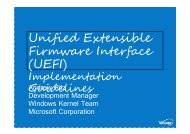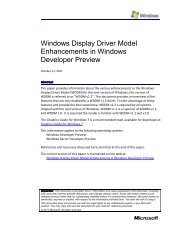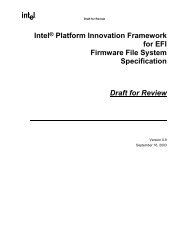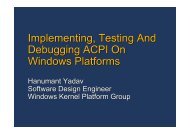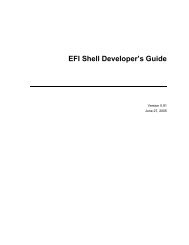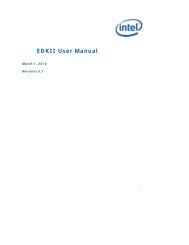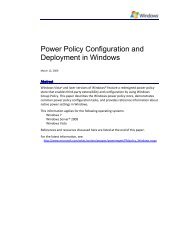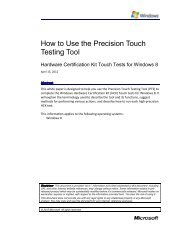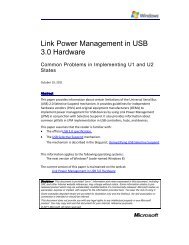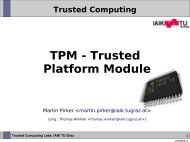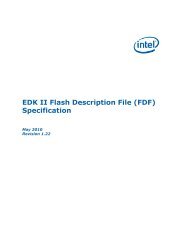SetupDesignGuide.pdf - Firmware Encoding Index
SetupDesignGuide.pdf - Firmware Encoding Index
SetupDesignGuide.pdf - Firmware Encoding Index
Create successful ePaper yourself
Turn your PDF publications into a flip-book with our unique Google optimized e-Paper software.
DRAFT<br />
1.5 Conventions Used in This Document<br />
This document uses typographic and illustrative conventions described below.<br />
1.5.1 Data Structure Descriptions<br />
The Intel Architecture processors of the IA-32 family are “little endian” machines. This means that<br />
the low-order byte of a multi-byte data item in memory is at the lowest address, while the highorder<br />
byte is at the highest address. Processors of the Itanium Processor Family (IPF) may be<br />
configured for both “little endian” and “big endian” operation. All implementations designed to<br />
conform to this specification will use “little endian” operation.<br />
In some memory layout descriptions, certain fields are marked reserved. Software must initialize<br />
such fields to zero, and ignore them when read. On an update operation, software must preserve<br />
any reserved field.<br />
1.5.2 Protocol Descriptions<br />
A protocol description generally has the following format:<br />
Protocol:<br />
Summary:<br />
GUID:<br />
Revision Number:<br />
Protocol Interface Struct<br />
Parameters:<br />
Related Definitions:<br />
Description:<br />
1.5.3 Procedure Descriptions<br />
The formal name of the protocol interface.<br />
A brief description of the protocol interface.<br />
The 128 bit unique identifier for the protocol interface.<br />
The revision of the protocol interface.<br />
A ‘C-style’ data structure definition containing the<br />
procedures and data fields produced by this protocol<br />
interface.<br />
A brief description of each field in the protocol interface<br />
structure.<br />
The type declarations and constants that are used in the<br />
protocol interface structure or any of its procedures.<br />
A description of the functionality provided by the<br />
protocol interface including any limitations and caveats<br />
the caller should be aware of.<br />
A procedure description generally has the following format:<br />
ProcedureName(): The formal name of the procedure.<br />
Summary:<br />
Prototype:<br />
Parameters:<br />
Related Definitions:<br />
A brief description of the procedure.<br />
A ‘C-style’ procedure header defining the calling<br />
sequence.<br />
The parameters defined in the template are described in<br />
further detail.<br />
The type declarations and constants that are only used by<br />
this procedure.<br />
1.



